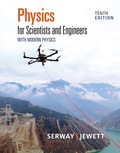
Physics for Scientists and Engineers with Modern Physics
10th Edition
ISBN: 9781337671729
Author: SERWAY
Publisher: Cengage
expand_more
expand_more
format_list_bulleted
Question
Chapter 43, Problem 5P
(a)
To determine
The fraction of the space.
(b)
To determine
The fraction of the space occupied.
Expert Solution & Answer
Want to see the full answer?
Check out a sample textbook solution
Students have asked these similar questions
A piece of metal is placed on top of a 2.0 - kg wooden block (mass density = 562 kg/m³) piece. UseArchimedes' principle to calculate the mass (in kg) of copper if the top of the wood surface is exactly at thewater's surface?
A filmmaker wants to achieve an interesting visual effect by filming a scene through a converging lens with a
focal length of 50.0 m. The lens is placed betwen the camera and a horse, which canters toward the camera
at a constant speed of 7.9 m/s. The camera starts rolling when the horse is 36.0 m from the lens. Find the
average speed of the image of the horse (a) during the first 2.0 s after the camera starts rolling and (b)
during the following 2.0 s.
Answer the question (Physics)
Chapter 43 Solutions
Physics for Scientists and Engineers with Modern Physics
Ch. 43.1 - Prob. 43.1QQCh. 43.5 - Prob. 43.3QQCh. 43.5 - Which of the following is the correct daughter...Ch. 43.8 - When a nucleus undergoes fission, the two daughter...Ch. 43.8 - Prob. 43.6QQCh. 43.10 - Prob. 43.7QQCh. 43 - Prob. 1PCh. 43 - Prob. 2PCh. 43 - Prob. 3PCh. 43 - Prob. 4P
Ch. 43 - Prob. 5PCh. 43 - Prob. 7PCh. 43 - Prob. 8PCh. 43 - Prob. 9PCh. 43 - Prob. 10PCh. 43 - Prob. 11PCh. 43 - Prob. 13PCh. 43 - Prob. 15PCh. 43 - Prob. 17PCh. 43 - Prob. 18PCh. 43 - Prob. 19PCh. 43 - Prob. 20PCh. 43 - Prob. 21PCh. 43 - Prob. 22PCh. 43 - Prob. 23PCh. 43 - Prob. 24PCh. 43 - Enter the correct nuclide symbol in each open tan...Ch. 43 - Prob. 26PCh. 43 - Prob. 27PCh. 43 - Prob. 28PCh. 43 - Prob. 29PCh. 43 - Prob. 30PCh. 43 - Prob. 32PCh. 43 - Prob. 33PCh. 43 - Prob. 35PCh. 43 - Prob. 37PCh. 43 - Prob. 39PCh. 43 - Prob. 41PCh. 43 - Prob. 42PCh. 43 - Prob. 44PCh. 43 - Prob. 45APCh. 43 - Prob. 46APCh. 43 - Prob. 47APCh. 43 - Prob. 48APCh. 43 - Prob. 49APCh. 43 - Prob. 50APCh. 43 - Prob. 51APCh. 43 - Prob. 52APCh. 43 - As part of his discovery of the neutron in 1932,...Ch. 43 - Prob. 55APCh. 43 - Prob. 56APCh. 43 - Prob. 58APCh. 43 - Prob. 59APCh. 43 - Prob. 60APCh. 43 - Prob. 62APCh. 43 - Prob. 63APCh. 43 - Prob. 64APCh. 43 - Prob. 65APCh. 43 - Prob. 66CP
Knowledge Booster
Similar questions
- Hi! I need help with these calculations for part i and part k for a physics Diffraction Lab. We used a slit width 0.4 mm to measure our pattern.arrow_forwardExamine the data and % error values in Data Table 3 where the angular displacement of the simple pendulum decreased but the mass of the pendulum bob and the length of the pendulum remained constant. Describe whether or not your data shows that the period of the pendulum depends on the angular displacement of the pendulum bob, to within a reasonable percent error.arrow_forwardIn addition to the anyalysis of the graph, show mathematically that the slope of that line is 2π/√g . Using the slope of your line calculate the value of g and compare it to 9.8.arrow_forward
- An object is placed 24.1 cm to the left of a diverging lens (f = -6.51 cm). A concave mirror (f= 14.8 cm) is placed 30.2 cm to the right of the lens to form an image of the first image formed by the lens. Find the final image distance, measured relative to the mirror. (b) Is the final image real or virtual? (c) Is the final image upright or inverted with respect to the original object?arrow_forwardConcept Simulation 26.4 provides the option of exploring the ray diagram that applies to this problem. The distance between an object and its image formed by a diverging lens is 5.90 cm. The focal length of the lens is -2.60 cm. Find (a) the image distance and (b) the object distance.arrow_forwardPls help ASAParrow_forward
arrow_back_ios
SEE MORE QUESTIONS
arrow_forward_ios
Recommended textbooks for you
 Physics for Scientists and Engineers: Foundations...PhysicsISBN:9781133939146Author:Katz, Debora M.Publisher:Cengage Learning
Physics for Scientists and Engineers: Foundations...PhysicsISBN:9781133939146Author:Katz, Debora M.Publisher:Cengage Learning College PhysicsPhysicsISBN:9781938168000Author:Paul Peter Urone, Roger HinrichsPublisher:OpenStax College
College PhysicsPhysicsISBN:9781938168000Author:Paul Peter Urone, Roger HinrichsPublisher:OpenStax College Modern PhysicsPhysicsISBN:9781111794378Author:Raymond A. Serway, Clement J. Moses, Curt A. MoyerPublisher:Cengage Learning
Modern PhysicsPhysicsISBN:9781111794378Author:Raymond A. Serway, Clement J. Moses, Curt A. MoyerPublisher:Cengage Learning Classical Dynamics of Particles and SystemsPhysicsISBN:9780534408961Author:Stephen T. Thornton, Jerry B. MarionPublisher:Cengage Learning
Classical Dynamics of Particles and SystemsPhysicsISBN:9780534408961Author:Stephen T. Thornton, Jerry B. MarionPublisher:Cengage Learning University Physics Volume 3PhysicsISBN:9781938168185Author:William Moebs, Jeff SannyPublisher:OpenStax
University Physics Volume 3PhysicsISBN:9781938168185Author:William Moebs, Jeff SannyPublisher:OpenStax

Physics for Scientists and Engineers: Foundations...
Physics
ISBN:9781133939146
Author:Katz, Debora M.
Publisher:Cengage Learning

College Physics
Physics
ISBN:9781938168000
Author:Paul Peter Urone, Roger Hinrichs
Publisher:OpenStax College

Modern Physics
Physics
ISBN:9781111794378
Author:Raymond A. Serway, Clement J. Moses, Curt A. Moyer
Publisher:Cengage Learning

Classical Dynamics of Particles and Systems
Physics
ISBN:9780534408961
Author:Stephen T. Thornton, Jerry B. Marion
Publisher:Cengage Learning

University Physics Volume 3
Physics
ISBN:9781938168185
Author:William Moebs, Jeff Sanny
Publisher:OpenStax
